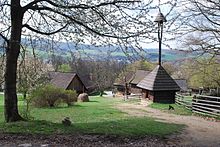Wallachian Open Air Museum
| Valašské muzeum v přírodě | |
 |
|
| Established | 1925 |
|---|---|
| Location | Rožnov pod Radhoštěm, Czech Republic |
| Coordinates | 49°27′40″N 18°09′14″E / 49.461°N 18.154°ECoordinates: 49°27′40″N 18°09′14″E / 49.461°N 18.154°E |
| Type | Open-air museum; ethnographic museum |
| Collections | Wallachian material culture |
| Founder | Bohumír Jaroněk |
The Wallachian Open Air Museum (Valašské muzeum v přírodě) is an open-air museum in Rožnov pod Radhoštěm, Moravian Wallachia, Czech Republic. The museum is devoted to preserving and displaying Wallachian material culture and traditions. It is the second oldest, and the largest open air museum in the Czech Republic.
The museum consists of three independent parts: the Little Wooden Town, the Wallachian Village and the Water Mill Valley. It is a listed national monument in the Czech Republic.
The museum was established by the Jaroněk brothers, who came from a working-class family of craftsmen and makers. Bohumír Jaroněk, a skilled painter and graphic artist, developed a particular interest in Wallachian timbered cottages. In 1895 he visited the Ethnological Czech-Slav Exhibition in Prague, where he has seen an open-air exhibition of Wallachian buildings. In 1909 the Jaroněk brothers settled in Rožnov, and shortly afterwards Alois Jaroněk travelled to the first open air museum in the world, the Stockholm Skansen.
Between 1911 and 1925 the brothers have been developing the concept of opening an open air museum in Rožnov and making it a reality. In 1925, during a folklore festival called „Wallachian year", the museum was opened. At that point it contained two large houses – the town hall and an 18th-century townhouse – and several smaller buildings. Gradually more buildings have been added to the complex. During the World War II a group of carpenters under Michal Fabián erected a wooden church, using plans of the church in Větřkovice near Příbor which had burned down in 1878. The original part of the museum has later become dubbed the Little Wooden Town.
The second part of the museum, the Wallachian Village, was gradually built in the 1960s. This part represents a typical Wallachian village and consists of approximately 40 buildings. The third division - the Watermill Valley - was opened in the 1980s and consists of several mills and other structures representing the work and manufacture carried out in the villages, allowing the visitors to get acquainted wth the traditional methods of production and working conditions.
The Little Wooden Town presents the traditional vernacular Moravian municipal architecture of the late 19th and early 20th centuries, and contains both relocated original buildings and reconstructions. The interiors have also been reconstructed to represent the traditional dwellings and institutions. The Little Wooden Town was brought into existence by moving several traditional stave houses from Rožnov Square into the present-day museum area, including the wooden Town Hall. Gradually new buildings were added including Vašek's Pub, the Mayor's House from Velké Kralovice and St. Anne's Church.
...
Wikipedia
